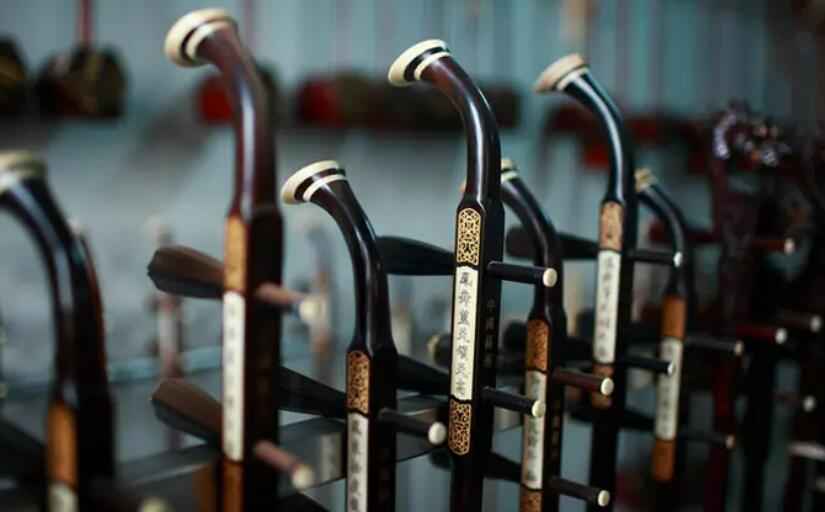Decades of musical instrument-making seals Meicun's place in traditional Chinese culture
Meicun town in Wuxi, East China's Jiangsu province, has long been regarded as the hometown of erhu, a two-stringed bowed traditional Chinese musical instrument. Such a reputation derives from the spirit of craftsmanship and dedication that master artisans in Meicun put into producing the instrument.
Meicun began producing erhu as early as 1965. Since then, more people have devoted themselves to the trade and Meicun later became a synonym for fine and exquisite erhu.
Huang Jianhong, head of the Meicun erhu guild, said Meicun is a major production base of erhu in China, with more than 10 brands and 10 workshops. More than 50,000 medium and high-end erhu are produced annually, which account for about a quarter of the domestic market. The annual output value of erhu in Meicun stands at about 50 million yuan ($7.1 million) and the annual export value has reached about 10 million yuan.
"This year, the production capacity of 18 member groups in Meicun is expected to reach 50,000 (instruments), and the orders we received saw an increase compared with 2019," Huang said. "Our guild is united in our desire to make authentic erhu by hand. Member groups in our guild make progress together."
According to Huang, Guyue Qinfang — an erhu workshop set up by his father-in-law, Wan Qi-xing, and operated by Huang — is making a batch of high-end professional erhu to be exported to Japan. The neck and sound box of each erhu is made of either Indian rosewood or red wood, with a laser label "Wuxi erhu".
Huang, who has been in the trade for more than 20 years, is a renowned erhu maker in Meicun. He learned skills from Wan, a master erhu maker, and has tried out various innovations to make erhu more appealing.
Having connected with erhu musicians in Shanghai and Su-zhou, Jiangsu province, Huang has refined the design of erhu from his workshop. Some have won gold and silver medals at contests organized by the Ministry of Culture and Tourism and the China National Art Association of Music Society.
His erhu have also ranked high in global contests, scooping him the top accolade of global erhu master artisan in 2012.
Rather than titles and awards, Huang said he is more conscious of affections by music lovers and musicians. "My understanding of erhu grows with age and experiences. I believe each erhu has its own temperament and musicians have their own preferences," he said.
Erhu musicians in Jiangnan, which refers to the regions around the lower reaches of the Yangtze River, are fond of melodious and joyful tones. Meanwhile, those living in the northern part of China prefer bright and high-pitched tones, he said. "There are also a group of musicians who focus on repertoire and style and usually have many erhu to ensure a plurality of artistic expression," he added.
Huang's attention to detail is echoed by all artisans with the guild. Chen Shuigen, an artisan at Guyue Qinfang, has been polishing the necks of erhu for 30 years. "It takes 10 to 20 years of practice to master this skill," Chen said. "All the polishing tools I use are designed by myself."
Another sophisticated technique during the erhu-making process is stretching snakeskin over the sound box.
"The depth of sound matters to erhu and good snakeskin can make the sound more powerful," Huang said. He added even a top artisan can only cover snakeskin on 10 instruments at most in a day. The thickness of each piece of snakeskin, the ways of binding and trimming, and different woods the instrument uses will result in changes in tone. Any error in the process will lead to unwanted turbulence.
In 2010, Meicun was titled the "hometown of erhu craft in Jiangsu". In 2011, erhu making in Meicun was placed on Jiangsu's list of intangible cultural heritage. Lu Linsheng, who is deceased, won the title of heir to Jiangsu's intangible cultural heritage. Artisans including Huang, Wan and Bu Guangjun won the title of Wuxi intangible cultural heritage heirs.
Meicun was honored as the "hometown of Chinese erhu" by the Chinese Musicians' Association in 2011. In 2012, erhu-making masters and erhu musicians in Meicun visited Boholt, Germany, where they entranced the international audience with traditional Chinese arts.
The town has also integrated erhu into residents' daily lives. In November 2017, an art center named after erhu artist Deng Jiandong was opened. One month later, Meicun signed agreements with the Jiangsu Provincial Musicians Association to host youth erhu contests.
There are a large number of erhu lovers in Meicun, who have passed the Grade 10 exam, the highest level for amateur erhu performer, Huang said. Local erhu performing groups, such as Hongteng Folk Orchestra, often receive invitations to stage erhu performances outside Meicun.
Erhu, shaped like an upside-down hammer, can be traced back to the instruments of northern China's nomadic tribes that were introduced to the Tang Dynasty (618-907).
The instrument has a profound connection with Wuxi, which is the hometown of Hua Yanjun, a blind street musician. His masterpiece Erquan Yingyue, or The Moon's Reflection on the Second Spring, remains one of the most frequently played erhu solos across the nation. Liu Tianhua, another legend in traditional Chinese music history and the leader of an academic school of erhu artists in China, was a native of Wuxi. He composed pieces such as Beautiful Night, Autumn Moon over the Han Palace and Marching on the Bright Road.






